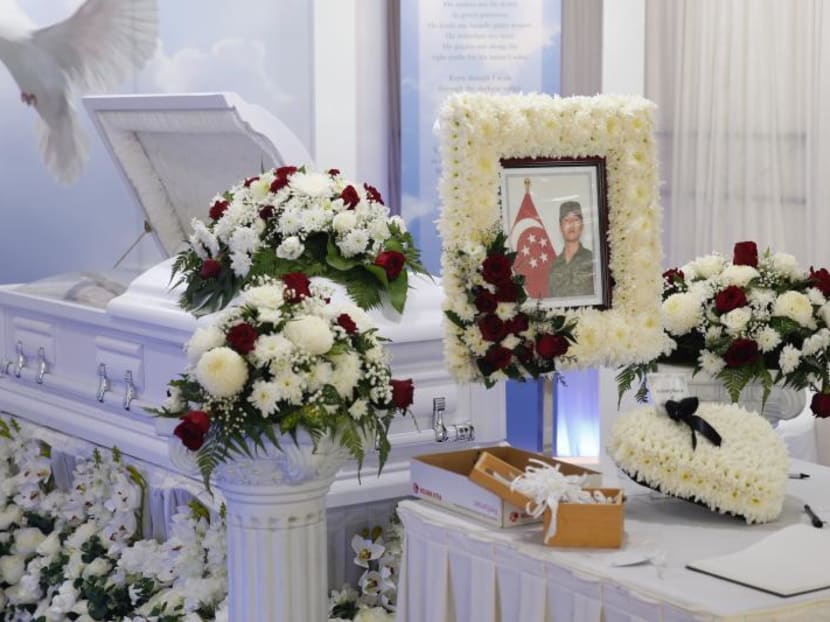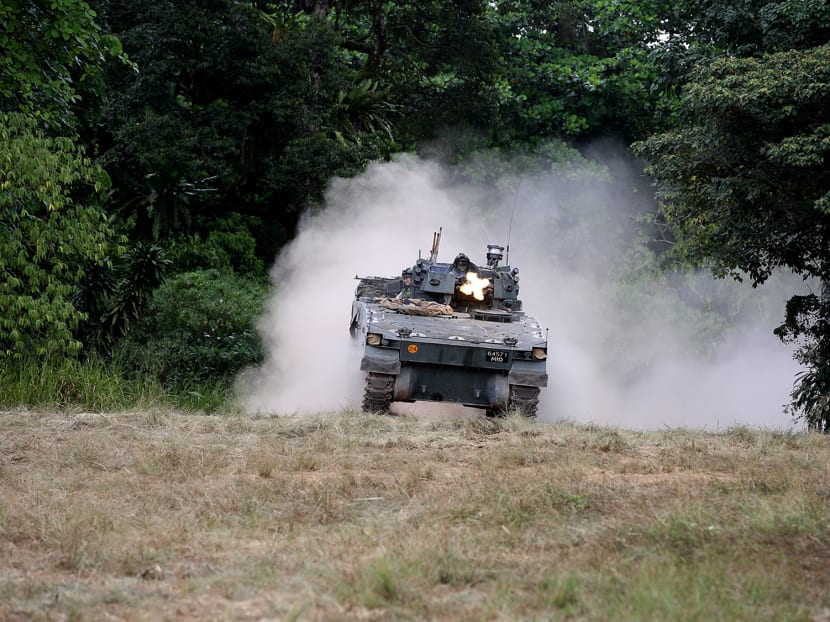NSF Liu Kai’s death: Bionix driver continued to reverse despite repeated orders to stop
SINGAPORE — Despite repeated orders from a vehicle specialist to stop reversing, the driver of a Bionix armoured vehicle did not hear the commands. The vehicle later mounted a Land Rover metres behind it — killing its driver, full-time national serviceman Liu Kai.

Corporal First Class Liu Kai was killed when a Bionix armoured vehicle reversed and mounted the Land Rover he was in.
SINGAPORE — Despite repeated orders from a specialist to stop reversing, the driver of a Bionix armoured vehicle continued to do so.
The vehicle later mounted a Land Rover metres behind it — killing its driver, full-time national serviceman Liu Kai.
Releasing these findings by an independent Committee of Inquiry (COI) looking into Liu’s death, Defence Minister Ng Eng Hen told Parliament on Monday (Feb 11) that the committee had found no mechanical problem with the Bionix’s steering equipment.
Corporal First Class Liu’s Land Rover was also in working order.
The 22-year-old transport operator from the Singapore Armed Forces’ (SAF) Transport Hub West died on Nov 3 last year of traumatic asphyxia, shortly after the accident during a mission exercise at Jalan Murai, near Lim Chu Kang. Traumatic asphyxia refers to an injury that causes an interruption of breathing.

Police investigations into the accident are continuing, following which the Attorney-General’s Chambers will decide if anyone should be prosecuted, Dr Ng said.
Even if the Attorney-General's Chambers does not bring criminal charges, the Defence Ministry will carry out its own investigations and may charge those who have breached military law in the military court, he added.
WHAT HAPPENED
The COI stitched together a detailed chronology of the events that morning via the Land Rover’s cameras that recorded events in front of and inside the vehicle, as well as statements from witnesses.
Walking Members of Parliament (MPs) through the sequence of events, Dr Ng said Liu was assigned to drive a trainer — an SAF regular who was a captain. The trainer from the Active Unit Training Centre was evaluating the exercise troops from the Land Rover, which was following its assigned Bionix as part of the exercise.
Four full-time national servicemen were in the Bionix: A vehicle commander (a Second Lieutenant); a rear guide who directed the vehicle in reversing (a Third Sergeant); as well as a driver and a gunner (both Corporals). A Bionix driver has no sight of what goes on behind, and hence, requires a rear guide’s directions.
-
At 9.58am, about three hours after the exercise began, the Bionix crew noticed several vehicles passing at a junction ahead of it and stopped on their commander’s orders. Responding to this, Liu also halted the Land Rover.
-
The trainer in the Land Rover later instructed Liu to overtake the Bionix, but as Liu began advancing slowly, shots were fired as part of the exercise. He stopped the vehicle on hearing the gunshots. Associate Professor Walter Theseira, a Nominated MP, asked why the trainer had instructed Liu to overtake the Bionix. Dr Ng replied that this was unclear to the COI and the matter had to be left to the police. He added that it has “legal implications”, without elaborating.
-
Based on the COI’s calculations, the Land Rover was, at most, 19.8m from the Bionix, less than the safe distance of 30m set out in training safety regulations.
-
Four seconds after Liu’s vehicle came to a halt, the Bionix carried out an “extrication drill” in response to the gunshots on orders from its commander, and began to reverse, said Dr Ng.
-
An extrication drill is carried out to get away from an enemy encounter as quickly as possible, and is part and parcel of the exercise.
-
While the Land Rover was not in the Bionix’s reverse path initially, the Bionix operator steered slightly to straighten its course, the COI found. This brought it into the path of Liu’s vehicle.
-
Almost immediately after the armoured vehicle started reversing, the rear guide was seen gesturing at Liu’s vehicle to move away. He also brought the mic of his helmet closer to his mouth.
-
He issued stop commands into his helmet set repeatedly — the intercom device via the helmet is the Bionix rear guide’s only means of communicating with other crew members on board.
-
But the Bionix continued to reverse.
The intercom system had been working earlier in the exercise, noted the COI, which has asked for an independent technical assessment and a report on whether the system was functioning throughout. It is not clear if the equipment had later failed.
Police investigations are focused on communications between the crew of the Bionix and whether the equipment had affected these exchanges, Dr Ng said.
Inside the Land Rover, the trainer tapped and signalled to Liu to reverse, based on video footage. Beep sounds indicated that Liu had engaged the reverse gear, said Dr Ng, though he did not mention if Liu managed to reverse at all.
The trainer and Liu shouted and gestured with their hands for the Bionix to stop, and the trainer also reached for a handset to talk to the crew on board the Bionix, added Dr Ng. The minister did not disclose if the trainer managed to establish contact.
Eight seconds or so after it began reversing, the Bionix mounted the driver’s side of the Land Rover before coming to a halt.
The trainer extricated himself, though Liu remained trapped.
A medic aboard a nearby Bionix attended to Liu, as did the SAF Emergency Ambulance Service, a unit medical officer, and the Singapore Civil Defence Force. Liu succumbed to his injuries and was pronounced dead at the scene at 10.35am.
POOR SIGNALS HAMPERED PLAN: COI
Dr Ng said the COI determined that a safety-management plan had been included as part of exercise, in accordance with standard practice. There was also adequate deployment of medics and medical equipment.
Still, the COI found that poor communication signals in the training area hampered the execution of the post-incident safety-management plan, which led to delays in contacting the chief safety officer and co-ordination difficulties with some responders.
It also found that the SAF’s medical response was based on the concept of rapid evacuation to the next level of care, but this may not be adequate when a casualty cannot be evacuated promptly, as in Liu’s case. The transport operators supporting the exercise — who were assigned only shortly before the exercise — also did not take part in the exercise brief and instead received separate briefs by their vehicle commanders.
In the aftermath of the accident, the SAF has and will put in place measures to prevent a recurrence, the minister said. These include having emergency-horn activation buttons in the rear crew compartment of all Bionix vehicles in its training fleet as well as rear-view cameras to aid Bionix drivers during reversing.
In response to the COI’s findings, the External Review Panel on SAF Safety — which oversees the conduct of safety and system reviews for the Defence Ministry and the SAF — said it agreed with the findings, and that the SAF could make potential improvements to its safety management and emergency response system.
Calling Liu a well-liked and respected soldier who served with pride, Dr Ng said the young man was remembered by his peers for his dedication.
“We mourn the loss of this precious son and we hope that the measures that the SAF has put in place will prevent a similar incident in the future.”
Liu, a Private who was posthumously accorded the rank of Corporal First Class, was the youngest and only son in a family of five.








